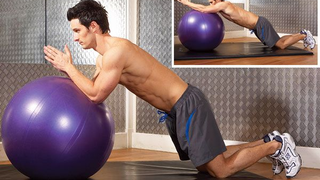Gym Ball, Swiss Ball, Yoga Ball, Pezzi Ball? What is it and WHY would you Possibly want one?
![]()
Note to Readers:
Aging_with_Pizzazz will be taking a Hiatus.
Keep up all your good work and I’ll be back
with you in the fall.
Upon mentioning my gym ball in a class recently, a guy asked me “well, what is a gym ball?” It was one of those moments when you stumble and wish you could just answer “you know… a gym ball.” Then I realized it could be confused with other names and products. My goodness, he may have even envisioned a medicine ball, which some of us might remember with less than delight.
The gym ball is round inflatable soft elastic material (usually from 35-85 cm, which is how they are generally listed). It has so many different names that I couldn’t even put them all in the title, although I almost tried. In alphabetical order (which in itself shows that there are numerous entries), those names include balance ball, birth ball (yes sometimes used in birthing), body ball, fitness ball, gym ball, gymnastic ball, physio ball, Pilates’s ball (these are often the tiny ones, not for sitting), Pezzi ball, stability ball, Swedish ball, Swiss ball (perhaps the original), Therapy ball, or Yoga ball. They are basically the same.
Advantages include that they are cheap, lightweight and are easy to inflate and deflate (depending on your pump, perhaps not even a minute). An inflation stem changes the air pressure by either filling the ball with air or letting the ball deflate when opened (or pulled out).
Another plus is that these balls are fun and marvelous for home workouts which I promote a good deal. (And yes, they are a ‘good deal.’)
Unstable Surface Training
While some experts don’t like ‘unstable’ platforms, they are still often used in Physical Therapy, therapeutic Exercise, athletic training and general exercise. Frequently, they’re an accompaniment to weight training.
Using an unstable surface is great at times for complex interaction in the body. True, if you’re seeking to work harder on specific parts of the frame, then a gym ball isn’t always your best bet. Still, I personally love gym balls, so that is a warning of my bias.
Benefits of an Exercise Ball
The degree of benefits from an exercise ball depends on how you use it. Do you just sit on it? Exercise with it? Bounce on it? Lift hand weights while balancing on it? Most of the advantages mentioned below are noted even with the simplest of use.
Increases circulation
One of the easiest things you do with a gym ball, namely just sitting, will improve circulation. As the body works to balance you and keep you from falling, it works many muscles, which in turn increases circulation.
Activation of core muscles
A Frequently cited benefit is activating and enhancing the core muscles, which in turn improve back and spinal health.
Strengthens muscles
Working to strengthen multiple muscle groups (particularly the core mentioned above), the ball can help stabilize the spine and increase lumbar (lower spine) support.
Reduces discomfort and pain
The activation and strengthening mentioned above often helps to reduce pain and discomfort associated with poor lumbar support. Mobilizing muscles in a gentle, constant manner (as in sitting on a ball) also works to reduce pain.
Improves Balance
Developing more strength in the core generally improves balance and coordination, which also leads to better posture and reduces the risk of falls. [There are numerous other posts on Aging_with_Pizzazz about avoiding falls (such as Are ‘Slips & Falls’ Inevitable as We Age? Maybe.) Muscles become stronger over time helping to keep your balance.
Accentuates Adaptability
When performing exercises on the ball we engage several muscle groups (beside core muscles). Different from regular floor exercise, this promotes constant adaptability of the body, offering a wider range of fitness. Without increasing the total effort load, the unstable surface recruits more muscle units. Experts will explain that it increases complexity, not intensity. For seniors, all of this leads to increase ease of ADLs (activities of daily living).
Works Lymphatic system
This was a new one on me, but some advocates claim that using a gym ball works your entire lymphatic system. The lymph system, which is tasked with draining toxins from your body, is stimulated by the work of the muscles. (This may be particularly true for bouncing behavior noted below and when done with proper alignment of body – head to hips.)
Rebounding
In the long ago past of this blog, I wrote about rebounding. I still like it, just got bored of writing about it. I covered the general concepts in The Ups and Downs of that Rebounder-thing, tips for purchasing in Buying into ‘Health Bounce’ Fitness – But at $25 or $450? and of course, benefits in Do the Benefits of Rebounding go Up and Down? There have been advances in the products and research since that time, and I wrote that I purchased a new one. But what I want to mention here is that some of the benefits of redounding can be found when bouncing on a gym ball. (You knew there was some connection coming, didn’t you?)
The caveat? You REALLY need to make sure that if you plan on doing bouncing that you purchase a good, anti-burst, puncture-resistant ball. I personally don’t use the ball this way, although I do often find myself bouncing lightly on it as I sit. I use a rebounder (even for HIIT) and don’t believe that the full benefits of rebounding can be found in bouncing on a gym ball. However, if you are in need of every small advantage you can get, this is a simple and gentle approach.
Notice I said ‘gentle’ and not easy. It’s not exactly difficult, but you need to be very careful of falling off a ball. Still, you wouldn’t have far to go, right?
Purchasing the Right Swiss Ball for You
My most useful tip is this – when sitting on your ball with knees bent, your knees should be at hip level with upper legs parallel to the ground. In case you are shopping at the 2nd hand store or the neighborhood garage sale, this is handy to know as you might not see the original box displaying the size. Keeping this tip in mind, you’ll have no problem avoiding a useless purchase.
Otherwise, the chart below lays out the size of your needed purchase. Let me advise you that NOT all charts are the same. There are discrepancies between them, but I have given this my best shot. You may wish to check with Mr. Google if you want to verify your size.
| Your Height | Approx. Ball Height | Ball Size |
|---|---|---|
| Under and Up to 4 ft. 2 in. | 14 in. | 35 cm – Small |
| 4 ft. 2 in. to 4 ft. 8 in. | 18 in. | 45 cm – Medium |
| 4 ft. 8 in. to 5 ft. 4 in. | 22 in. | 55 cm – Large |
| 5 ft.5 in. to 5 ft. 10 in. | 26 in. | 65 cm – X large |
| 5 ft. 11 in, to 6 ft. 4 in. | 30 in. | 75 cm – X X Large |
| Over 6 ft. 5 in) | 34 in. | 85/90 cm – XXX Large |
(At 5.4 I use a 55 cm ball.)
Make sure it’s an “anti-burst” or “puncture-resistant” ball. The good news is that most are.
Regarding cost, you shouldn’t have to pay over $20 for a good ball. And many online places have them less expensive. Don’t worry too much about buying second hand either, especially if you aren’t doing a lot of bouncing. I don’t even want to guess how old my ball is now.
Starting to Use your Gym Ball
I decided that there is little use in overwhelming readers (hopefully potential gym-ball users) with multiple exercise. The array of those exercises is vaster than you might suppose. When people begin to use a ball, they come to love the ball and find more and more ways to incorporate it into workouts.
Sometime in the months to come, I may do a follow-up post on specific gym-ball exercises for seniors. In the meantime, I’m going to address only two.
The Senior Sit
Can sitting ever really be an exercise? Oh, yes. And muscles can benefit from it (as well as balance). After purchasing a ball, take a few opportunities to sit on it without other distractions. For some, it can take getting used to.
When balanced, move around on the ball, pushing the pelvis forward and backward and to the sides (as if pushing hips to left and right). This particular movement can be extremely useful for those suffering back pain and can do little else. Back pain or not, you can often feel the ‘tight’ spots we have developed over the years.
Later, use the ball while doing other things like watching TV, knitting, reading, hobby work or writing if you have a low enough work surface. The slight movement you use to maintain and balance yourself offers all the nuanced benefits mentioned earlier.
Finally, yes, I admit it, I made up the name “senior sit.” This can benefit those of any age.
The Gym Ball Roll-Out
I pick this as a favorite exercise moving forward (a pun) on the gym ball. It’s gentle but can be a significant workout. Additionally, beginning from the ground, it can feel more secure to seniors just starting out. You can move forward (or roll the ball out) to the extent you think you handle, allowing you to increase the movement and effort over the weeks.
Lower yourself to the floor and kneel in front of the ball. Rest your forearms on the ball in front of you. Place your knees back as far as possible while maintaining the arm position. Slowly, extend your arms to roll the ball forwards, by using your core (abdominal) muscles to control the wobble of the ball. Concentrate on  keeping the ball and your body steady. Then slowly reverse and roll the ball back again, returning to your starting point. Try to keep your back flat throughout; this can be a bit difficult. For your first couple attempts, it’s more important to sustain good form than to reach full extension of your torso and arms.
keeping the ball and your body steady. Then slowly reverse and roll the ball back again, returning to your starting point. Try to keep your back flat throughout; this can be a bit difficult. For your first couple attempts, it’s more important to sustain good form than to reach full extension of your torso and arms.
Did you hear that the local gym
had to send one of its gym balls to therapy?
When asked by those working out what was going on,
the manager said the sad ball
couldn’t handle the pressure and kept letting people down!
FINAL THOUGHT
Even with Pizzazz, Aging isn’t for wimps. I figure it’s good to have a tough pair of balls on your side.
—
References: For more information, visit.
5 fantastic reasons why you need to add an exercise ball to your workouts | HealthShots
Benefits of Using an Exercise Ball | Health and Care
—
Credits: Title photo – Layered sphere Image by SH Saw Myint from Pixabay
Male exerciser on ball – (Image credit: Unknown)
The post Gym Ball, Swiss Ball, Yoga Ball, Pezzi Ball? What is it and WHY would you Possibly want one? appeared first on Aging with Pizzazz.

























